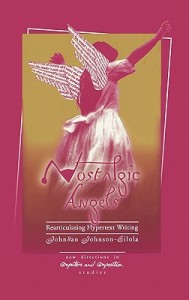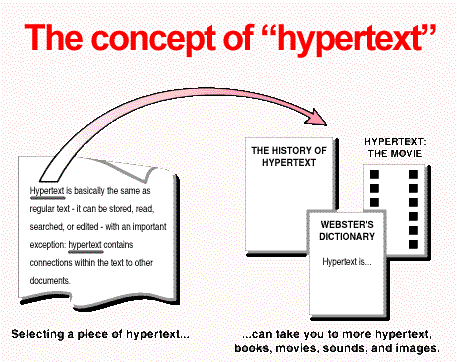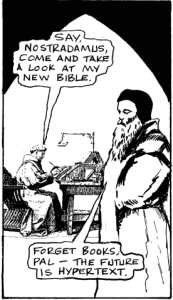Prior to this week’s readings, I had always thought of hypertext as tools or links to other text. They were simply a way to reference and connect to other text. The readings definitely complicated my reading of hypertext and confirm my unconscious obsession with agency and the relation between the reader/audience and writer/speaker.
Michael Joyce’s chapter “Hypertext and Hypermedia” from Of Two Minds: Hypertext Pedagogy and  Poetics provided a much needed history of hypertext. I never made a distinction between hypertext, hypermedia, and multimedia. What struck me the most from Joyce’s work was his statement about the role of readers and writers in regards to hypertext. Joyce states, “Hypertext readers not only choose the order of what they read but, in doing so, also alter its form by their choices” (19). This was interesting to me because everything we read (Biesecker and Foucualt come to mind) seems to come back to the idea that things are non-linear and do not exists in binaries. that there isn’t a binary between speaker and audience, reader and writer. Hypertext is dynamic and interactive.
Poetics provided a much needed history of hypertext. I never made a distinction between hypertext, hypermedia, and multimedia. What struck me the most from Joyce’s work was his statement about the role of readers and writers in regards to hypertext. Joyce states, “Hypertext readers not only choose the order of what they read but, in doing so, also alter its form by their choices” (19). This was interesting to me because everything we read (Biesecker and Foucualt come to mind) seems to come back to the idea that things are non-linear and do not exists in binaries. that there isn’t a binary between speaker and audience, reader and writer. Hypertext is dynamic and interactive.
This thread also jumped out at me in Johndan Johnson-Eilola’s Nostalgic Angels: Rearticulating Hypertext Writing. Johnson-Eilola begins his work:
“Writing has always been about borders, about the processes of mapping and remapping the lines of separation between things. Writing constructs implicit and explicit boundaries between not only products and process and said and unsaid, but author and reader, literacy and orality, technology and nature, self and other” (3).
This quote was significant to me in that Johnson-Eiloa seemed to be working towards deconstructing the borders between author and reader, moving beyond the binary. He also argues for an expansion of what counts as composition, saying:
“We must find a way in which to talk and think about writing as a complex activity evaluating not only writers but also readers, texts, societies, politics, economies and technologies (as well as the complicated way each of these terms is articulated)” (18).
All of these theories move away from a linear and flat presentation of writing and rhetorical discourse to a non-linear and dynamic presentation. This is significant if we are to think of networks as being active. There is movement and interaction not in one direction or two directions but in multiple directions, each connecting with and feeding back into the other. I think Johnson-Eilola emphasizes this when he says:
We recognize the apparently radical enactment of nonlinearity inherent in the node-link structure of all hypertext; we proclaim in various ways that revolutionary potential; and then we immediately rearticulate those potentials in terms of our conventional, normal practices. (13-14)
We have a tendency to present old ways via new technologies. Instead of embracing the “revolutionary potential” of hypertext, we are using this text in the same ways that we would the print text.
All of this week’s reading challenge linearity and authority. As I was reading the history of hypertext and its grounding in uptoia and postmodernism, I immediately thought of Jameson’s Postmodernism and Consumer Society (which Johnson-Eilola mentions).Jameson discusses the lack of true authorship via the “death of the subject,” which is the idea that the idea of an individual self with agency is a thing of the past or an ideological construct that never existed. This calls into the question the idea that their can something such as an identity or an author. In addition, the non-linear nature of hypertext in conjunction with the way in which hypertext is not consumed by the masses via the Internet brought postmodernism and consumerism to mind. Based on the way hypertext is used today, It is hard to see it as a revolutionary text/tool.
Viewing hypertext as something that complicates the relationship between author, subject, and audience is intriguing to me (as someone interested in rhetoric and Snapchat). Johnson-Eilola’s call for a change in the way writers and readers work within the same space brought Biesecker’s work with the rhetorical situation to mind. Johnson-Eilola states, hypertext ” must allow writers and readers to work within the space of the texts (rather than downloading them, preserving the purity of the master text). Second, it must encourage more than one person to write within that space (in order to avoid pitting the weight of a published author against a single reader) (21).
This is a dynamic relationship between writer, reader, and the text. This also adds the politics of the space to the interaction, focusing on collaboration and multiple authors rather than “the weight of a published author against a single reader” (21). This conception of hypertext creates the idea that the writing and reading of the text can take place at the same time.
If hypertext should reach its revolutionary potential, what would that look like? I was intrigued by the idea of hypertext pedagogy, but I cannot say that I have been able to internalize or process what Johnson-Eilola presented. I am encouraged to explore hypertext more in regards to First Year Composition. I want to end with a quote that I think encapsulates what first-year composition should achieve (whether through hypertext or old fashioned text):
Imperfect angels, nostalgic for a past that never was, we might instead learn to live as cyborgs. In mapping hypertext use we do not create a new world from nothing, but we do create discourses in which old worlds might be transformed. (242)
The video below, though not related to hypertext, fit in with the thread of authorship and the relation between author, audience, and text:
Author as Replacement from Daniel Apollon on Vimeo.
Works Cited:
Johnson-Eilola, Johndan. Nostalgic Angels: Rearticulating Hypertext Writing. Norwood, NJ: Ablex Publishing Corporation, 1997. Print.
Joyce, Michael. Of Two Minds: Hypertext Pedagogy and Poetics. Ann Arbor, MI: University of Michigan Press, 1996. Print.


March 4, 2014 at 1:15 pm
I’m glad the readings this week got you to think about hypertext as more than a functionality (I usually “live” there in thinking about it as well). I too like the interplay between author, audience, and agency that these texts get us to think about. It brings me back to questions about intentionality/motivation/purpose and meaning.